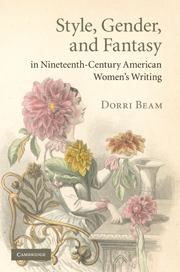Book contents
- Frontmatter
- Contents
- Acknowledgements
- Introduction. Highly wrought style
- 1 Florid fantasies: Fuller, Stephens, and the “other” language of flowers
- 2 Sensing the soul: mesmerism, feminism, and highly wrought fiction
- 3 Harriet Prescott Spofford's philosophy of composition
- 4 Pauline Hopkins' baroque folds: the styled form of Winona
- Coda: The value of ornament: Gilman and Wharton
- Notes
- Bibliography
- Index
4 - Pauline Hopkins' baroque folds: the styled form of Winona
Published online by Cambridge University Press: 05 October 2010
- Frontmatter
- Contents
- Acknowledgements
- Introduction. Highly wrought style
- 1 Florid fantasies: Fuller, Stephens, and the “other” language of flowers
- 2 Sensing the soul: mesmerism, feminism, and highly wrought fiction
- 3 Harriet Prescott Spofford's philosophy of composition
- 4 Pauline Hopkins' baroque folds: the styled form of Winona
- Coda: The value of ornament: Gilman and Wharton
- Notes
- Bibliography
- Index
Summary
In an 1892 essay titled “Pomegranate Flower and Apple Blossom,” Harriet Prescott Spofford seems to denounce her earlier, lush style by celebrating the ethereal delicacy of New England native flowers over the exotics to which her early writing was so frequently compared. Yet, closer consideration reveals that Spofford's highly wrought technique continues unabashed in this essay, though there has been a modification in the favored subject matter that yields a shift in emphasis toward a more evanescent materiality. Spofford still inundates the reader with waves of lavish prose as she recounts the seasonal procession of New England blooms. In the essay, the eponymous apple blossom is not the opposite of the pomegranate flower; rather, the native flower rivals the tropical with its finer, but no less intricate and fascinating material aspect: “How gauzy, fine, and thin is each separate floret of the dandelion! How like something only just thicker than twilight is the tissue of the wood-violet! And how, with scarcely more substance than a sunset cloud, comes the scarlet columbine springing like a tongue of flame from the rocky crannies!” (Pomegranate Flower, 450). The native flowers are less easy to overlook when Spofford amplifies their sensual presence through her prose. Spofford's stylistic virtuosity crowns the essay, in which the “refined” and the “delicate” are only deceptively moral values; refinement is here the mode by which materiality becomes ever more supple and sensuous.
- Type
- Chapter
- Information
- Publisher: Cambridge University PressPrint publication year: 2010



